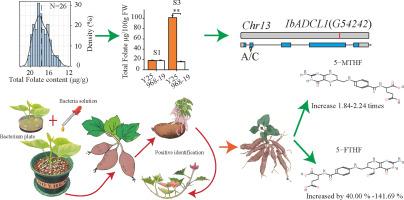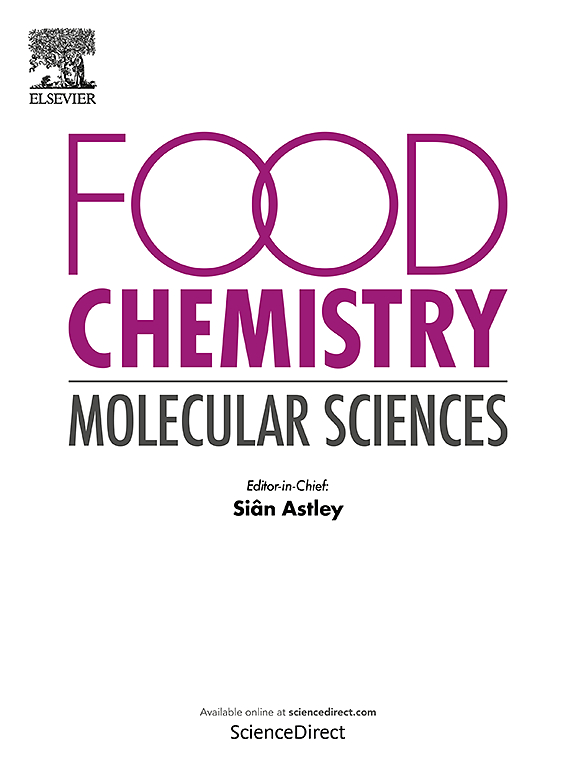综合转录组学和代谢组学分析鉴定IbADCL1是甘薯储存根中叶酸生物合成的关键调节因子
IF 4.7
Q2 FOOD SCIENCE & TECHNOLOGY
引用次数: 0
摘要
我们假设叶酸生物合成途径的关键调控基因可以通过综合多组学分析识别并功能验证,以促进叶酸在甘薯储存根中的积累。叶酸是植物代谢和人类饮食中必需的微量营养素,但其在甘薯储存根中的积累机制尚不清楚。对26个品种进行比较分析,鉴定出低叶酸(968-19)和高叶酸(Y25)品种。不同发育阶段块茎组织的综合多组学分析显示,5-甲基四氢叶酸(5-MTHF)和5-甲酰四氢叶酸(5-FTHF)是叶酸变化的主要决定因素。差异表达分析确定编码4-氨基-4-脱氧choris酸裂解酶的IbADCL1为推测的调控基因。与野生型对照相比,968-19年IbADCL1的异源过表达引发总叶酸增加177-222%,5-MTHF和5-FTHF水平分别升高184-224%和40-142%。本研究确定了IbADCL1作为叶酸生物合成的限速控制器,为代谢工程提高甘薯营养品质提供了分子靶点。本文章由计算机程序翻译,如有差异,请以英文原文为准。

Integrated transcriptomic and metabolomic profiling identifies IbADCL1 as a key regulator of folate biosynthesis in sweet potato storage roots
We hypothesized that key regulatory genes in the folate biosynthesis pathway could be identified through integrated multi-omics analysis and functionally validated to enhance folate accumulation in sweet potato storage roots. Folate, an essential micronutrient in plant metabolism and human diets, shows poorly characterized accumulation mechanisms in sweet potato storage roots. Comparative profiling of 26 cultivars identified low- (968–19) and high-folate (Y25) varieties. Integrated multi-omics analysis of tuber tissues across developmental stages revealed 5-methyltetrahydrofolate (5-MTHF) and 5-formyltetrahydrofolate (5-FTHF) as principal determinants of folate variation. Differential expression analysis pinpointed IbADCL1, encoding 4-amino-4-deoxychorismate lyase, as a putative regulatory gene. Heterologous overexpression of IbADCL1 in 968–19 triggered 177–222% increases in total folate, with 5-MTHF and 5-FTHF levels elevated by 184–224% and 40–142%, respectively, versus wild-type controls. This study establishes IbADCL1 as a rate-limiting controller of folate biosynthesis, offering molecular targets for metabolic engineering to enhance nutritional quality in sweet potato.
求助全文
通过发布文献求助,成功后即可免费获取论文全文。
去求助
来源期刊

Food Chemistry Molecular Sciences
Agricultural and Biological Sciences-Food Science
CiteScore
6.00
自引率
0.00%
发文量
83
审稿时长
82 days
期刊介绍:
Food Chemistry: Molecular Sciences is one of three companion journals to the highly respected Food Chemistry.
Food Chemistry: Molecular Sciences is an open access journal publishing research advancing the theory and practice of molecular sciences of foods.
The types of articles considered are original research articles, analytical methods, comprehensive reviews and commentaries.
Topics include:
Molecular sciences relating to major and minor components of food (nutrients and bioactives) and their physiological, sensory, flavour, and microbiological aspects; data must be sufficient to demonstrate relevance to foods and as consumed by humans
Changes in molecular composition or structure in foods occurring or induced during growth, distribution and processing (industrial or domestic) or as a result of human metabolism
Quality, safety, authenticity and traceability of foods and packaging materials
Valorisation of food waste arising from processing and exploitation of by-products
Molecular sciences of additives, contaminants including agro-chemicals, together with their metabolism, food fate and benefit: risk to human health
Novel analytical and computational (bioinformatics) methods related to foods as consumed, nutrients and bioactives, sensory, metabolic fate, and origins of foods. Articles must be concerned with new or novel methods or novel uses and must be applied to real-world samples to demonstrate robustness. Those dealing with significant improvements to existing methods or foods and commodities from different regions, and re-use of existing data will be considered, provided authors can establish sufficient originality.
 求助内容:
求助内容: 应助结果提醒方式:
应助结果提醒方式:


